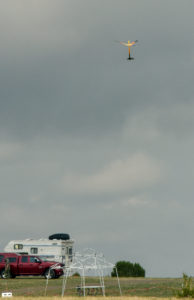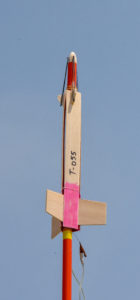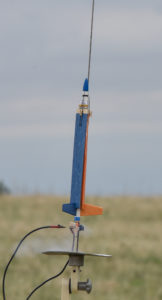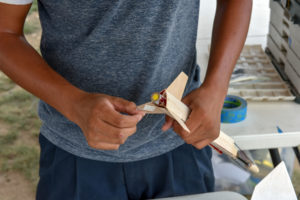Helicopter Duration
|
OVERVIEW For the full rules for this event, please see the Helicopter Duration rules in the Model Rocket Sporting Code. SCORING
GENERAL TIPS Rotaroc (designed by George Gassaway). See the plan in the files section below. There have been variations by others, such as the QCR High Rotor kits and the Apogee Heli-Roc kit. The basic design is a straight body tube with simple blades folded flat to the tube on boost, the folded blades in a triangular cross-section. The design is not too hard to build, though some people dislike attaching the hinges. It’s a reliable competitive design that usually puts in solid flights. Rose-A-Roc (designed by Art Rose). Offered as a kit by FlisKits. Plan is provided below. There have been variations designed by others, such as the Whirl-A-While by John DeMar (see the files below). The basic design is to make the model as small in cross-section as possible. So the blades split lengthwise, so the chord is half of normal, then folds rearwards to be parallel to the body. Rather than a body tube, most of the body is replaced by graphite tubing or a wood dowel, to give the rotor blades clearance for their lengthwise folds and to have a smaller cross section (frontal view). These models boost higher than Rotaroc type models. In the hands of a good builder, they can out-perform Rotarocs. They are harder to build than Rotaroc types. Internal Blade. There is another design which can be very competitive, which involves storing the blades inside of the body tube. This is what is used in FAI (international) competition. To do this effectively, the model needs to have a diameter large enough to hold reasonable sized blades, without the body weighing too much. In any case, the models are quite difficult, high payoff if they work but at a higher risk than more conventional models. So, this is not really recommended for newer competitors to try. Qualified Flights. OK, sometimes performance does not matter. For various reasons, whether for return or flight points, people just want to fly something that will qualify as a helicopter flight. A simple design that some use is the Texas Twister kit from Apogee. Deployment Magic. The Rotaroc and Rose-a-roc type designs use the ejection charge only as a starting point to cause the design to go from rocket boost mode to deploy for helicopter descent. Rubber bands are used to make the blades deploy. What keeps them from moving until ejection? Usually a burn-thread which is rigged to hold the model n boost mode. At ejection, the thread burns, allowing the rubber bands to do their thing. The burn thread needs to be thin. The button and carpet type of thread that Estes uses for shroud lines is too thick for anything short of a D12 ejection charge to burn. So use a finer thread. I prefer to use white elastic thread. The Rotaroc plans show how to run the thread to hold the blades. The rubber bands need to be selected carefully. Do not just grab any rubber band and try to force it to stretch really far, as the blades may bow outwards a lot when prepped for boost, or the hinges may be ripped off from too much force at deployment. Look for rubber bands with 1/16″ cross sections, in various lengths , at office supply type stores. Look for the classic pale brown latex bands, colored bands tend to not stretch as much. While the band should not be stretched so much that it causes excessive force, it should not be relaxed at the end of travel so that there is slack, as the blades might not deploy fully. This is not hard to get right, just it can cause trouble if it’s overlooked.
The most suitable hinges for the blades are the small hinges made by Du-Bro. However for models like Rotarocs, it is very useful to be able to remove the hinge pins for some assembly steps, and the Du-Bro hinge pins are not meant to be removed. The hinge pins can be modified though, either using vice-grips to un-crimp the crimped end, or using a Dremel tool with cut-off wheel to remove the flattened crimped end of the hinge pin. Attaching the hinges to the body tube is often the hardest part for some people to do. Fortunately, it is possible to make jigs that greatly assist in attaching the hinges, and attaching them at the same angle every time. A 4 degree hinge skew angle is suitable for most helicopter models, unless the plans specify different. Rotor Blades. Take note of which direction that the model will be rotating, so that you build the rotor blades to rotate the same way! Rotors are much like making wings for rocket boosted gliders. Except the rotors are smaller in chord and tend to be more fragile. Weight is a an important issue for helicopter models, regardless of design. The lighter, the better, as long as the blades (and the rest of the model) are physically strong enough. Try to find reasonably light balsa for the rotor blades, but without being so weak that the blades will bow outwards too easily when the blades are folded for boost. Long narrow blades can be hard to sand to shape, as they are so relatively fragile. See the Rotaroc-A plans to see how the trailing edge portions of the blades can be sanded to rough shape while still attached to 3″ wide balsa sheeting, then after cutting off the first blade the other trailing edge can be shaped with the resulting 2″ wide sheet. Using that method, the bulk of the difficult shaping (trailing edge) can be done to the blades before they are all cut to their final 1″ width. Of course, the blades should be shaped and finished before they are glued to the model. When doing very rough shaping for rotor blades, 80 to 120 grit sandpaper is good to grind off a lot of wood in a short time. Don’t over-do it though by sanding off too much. Then go to finer grit like 180 to 220 for finer shaping. Beyond that, 280/320 paper, is sort of a cross between final shaping and setting up for a final finish. A final finish for bare balsa is to use 400 grit paper. Get the “black” type wet or dry sandpaper, it sands better and lasts longer than the reddish types. If you use any clear dope, use 320 to 400 grit paper before and after. Helicopter Model Finish. Never use paint. For newer fliers, no finish is usually fine, better than weighting the model down too much and maybe having warpage problems. If you want to improve the finish on the blades, use some thinned clear dope in one or two light coats, sanding before and after with 240 and 400 grit sandpaper. The idea it not to weigh the model down too much, or add so much that the wood parts might tend to warp too easily.
Prepping. It’s usually easier to prep for flight by having the rubber bands unhooked, when setting the blades or tying the blades for boost. Hooking up the rubber bands afterwards. As long as you don’t forget the hooking up the bands step before launch! To prep helicopter models that use burn threads, it can be useful to use something to act like a needle threader to carry the thread thru the two small holes in the body. A simple tool is to take a 12″ long piece of .015″ music wire, and fold it sharply in half. The resulting tool can be pressed thru the small holes easily, the thread slipped inside the bent portion, then the thread pulled thru the holes in the body so the thread is passed to the other side. Don’t forget to hook up those rubber bands now… Flying. Regardless of design, try to fly it in a manner so it will not weathercock a lot into the wind (angle a little bit downwind, relative to how windy it is). For one, that will make the model eject higher up and therefore get a better time (always a plus). But the other is that the model might never deploy at all. If the model goes beyond apogee and is falling towards the ground at a good speed, the rubber bands might not be able to overcome the high aerodynamic forces, letting the model plummet to the ground. This is not too likely for 1/2A, but it is a consideration in higher power classes.
Helicopters are generally draggy unless they use blades internal to a body. Because of their drag they do not coast very long, so you usually need a short delay time on the motor so they are not headed downward at ejection — it is hard for the blades to open against any significant downward velocity and the transition to rotation goes better if the rocket is “nose upward” at ejection. You also generally want a motor with a lower average thrust to spread the total impulse out gently over a longer period of time and avoid reaching the “speed of balsa” on the external blades during boost. KITS |
Related Documents:
| Helicopter Duration (Barber) | May 28, 2014, 9:25 pm | 735 KB | |
| Helo Duration (Barklage) | May 28, 2014, 9:25 pm | 125 KB | |
| Helo Duration Design (Pinkas & Wickart) | May 28, 2014, 9:25 pm | 365 KB | |
| Mini-Rotaroc A HD (Gassaway) | May 28, 2014, 9:25 pm | 13 KB | |
| Rose-a-Roc B-C HD (Rose) | May 28, 2014, 9:25 pm | 140 KB | |
| Rotacrock 20 A HD (Kaplow) | May 28, 2014, 9:25 pm | 2 MB | |
| Rotaroc B&C HD (Gassaway) | May 28, 2014, 9:25 pm | 16 KB | |
| Whirl-a-While A HD (DeMar) | May 28, 2014, 9:25 pm | 30 KB |



 Building Helicopter Models. The two most critical parts of most helicopter models are the rotor blades, and the hinges that connect the blades to the main body.
Building Helicopter Models. The two most critical parts of most helicopter models are the rotor blades, and the hinges that connect the blades to the main body. Coloring. Bare balsa (even with clear dope) is not easy to see in the air or on the ground. Use a large black magic marker to color the bottom of the rotor blades black, as that shows up against the sky pretty well. But leave the last 3-4″ of the blades uncolored. Color those last 3-4″, both top and bottom, with a large red or orange magic marker. If you can find true fluorescent markers (not to be confused with wimpy fluorescent highlighters), an orange or red/magenta fluorescent color is highly recommended. The reason for the bright color for the last 3-4″ of the blades is that when the helicopter model lands, it usually falls over on two blades, leaving the other blade sticking upwards like a “flag”. So, colors on the blade tips can help you find the model.
Coloring. Bare balsa (even with clear dope) is not easy to see in the air or on the ground. Use a large black magic marker to color the bottom of the rotor blades black, as that shows up against the sky pretty well. But leave the last 3-4″ of the blades uncolored. Color those last 3-4″, both top and bottom, with a large red or orange magic marker. If you can find true fluorescent markers (not to be confused with wimpy fluorescent highlighters), an orange or red/magenta fluorescent color is highly recommended. The reason for the bright color for the last 3-4″ of the blades is that when the helicopter model lands, it usually falls over on two blades, leaving the other blade sticking upwards like a “flag”. So, colors on the blade tips can help you find the model. MOTOR SELECTION
MOTOR SELECTION